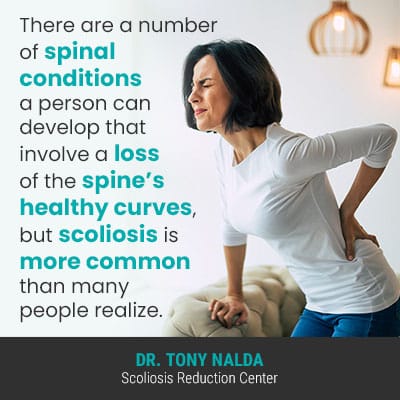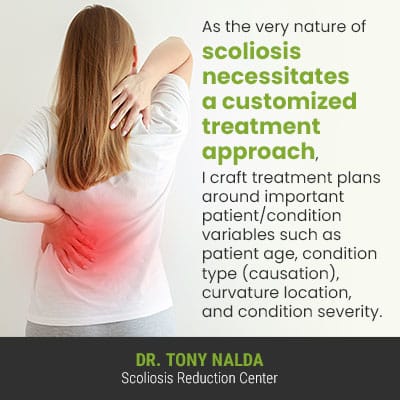There are many different types of scoliosis, with unique causes and treatment needs, and there is also a wide range of severity levels from mild to moderate and severe to very severe. To complicate things further, there are also vastly-different approaches to scoliosis treatment, each offering patients a different potential outcome. Continue reading to learn how each treatment approach responds to a diagnosis of a 15-degree scoliosis.
With a 15 degrees scoliosis, this is classified as mild scoliosis. What happens after a diagnosis of mild scoliosis will depend on which treatment approach a patient commits to, but what should happen is proactive treatment that focuses on impacting the condition on a structural level.
There are two main scoliosis treatment approaches, but before we get into those, let’s first talk about how the condition is diagnosed and classified.
Diagnosing and Classifying Scoliosis
If a person suspects they have scoliosis, or as in many adolescent cases, a parent or caregiver notices early signs of the condition, being assessed and diagnosed is the next step.

There are a number of spinal conditions a person can develop that involve a loss of the spine’s healthy curves, but scoliosis is more common than many people realize.
Scoliosis is not only the most prevalent spinal condition amongst school-aged children, but the National Scoliosis Foundation has estimates of close to 7 million people currently living with the condition in the United States alone.
In order for a scoliosis diagnosis to be reached, certain parameters have to be met: an unnatural sideways spinal curve, with rotation, making it a 3-dimensional condition, and a minimum Cobb angle of 10 degrees has to be present.
Cobb angle is a measurement obtained during X-ray that’s expressed in degrees, where lines are drawn from the tops and bottoms of the curve’s most-tilted vertebrae at its apex, and the resulting angle places conditions on a severity scale of mild to moderate and severe to very severe:
- Mild scoliosis: Cobb angle measurement of between 10 and 25 degrees
- Moderate scoliosis: Cobb angle measurement of between 25 and 40 degrees
- Severe scoliosis: Cobb angle measurement of 40+ degrees
- Very-severe scoliosis: Cobb angle measurement of 80+ degrees
The diagnostic cut-off point for scoliosis was decided as 10 degrees, quite simply, because there had to be a consistent and clear diagnostic protocol in place, particularly with a condition as prevalent and variable as scoliosis.
So as you can see from the above Cobb angle measurements, a 15-degree scoliosis would fall within the range of mild scoliosis and be classified as such.
So once that diagnosis is given, what happens next?
Treatment Options for a 15-Degree Scoliosis
When it comes to how to address a mild scoliosis diagnosis, the time to seek treatment is always now, especially in light of the condition’s progressive nature: meaning it will naturally worsen over time, particularly if left untreated, or not treated proactively.
It is crucial, however, for patients and their families to understand that there are two main scoliosis treatment approaches to choose between because each approach offers patients a different potential outcome.
As the condition’s most-prevalent type is adolescent idiopathic scoliosis (AIS), diagnosed between the ages of 10 and 18, this is the form we’ll be focusing on throughout the article.
The two main scoliosis treatment approaches to choose between are traditional and conservative, aka functional and/or chiropractic-centered.
Traditional is Watch and Wait
While the traditional approach to scoliosis treatment has been in place for many years, it has changed little over those years, despite our growing understanding of the condition and how it responds to treatment.
The main response to an adolescent with mild scoliosis is to watch and wait. In most cases, adolescents with a 15 degree scoliosis would be told that as the condition is mild, it should be monitored for progression at periodic intervals.
Depending on the treatment provider, those intervals can be anywhere between every 3, 6, to even 12 months.
The idiopathic designation in AIS means not clearly associated with any single-known cause, meaning we don’t understand its etiology; however, we do understand what triggers the condition’s progression, and that’s growth and development.
Considering the stage of growth and development that adolescents are in, or entering into, this age group is at risk for rapid-phase progression.
What happens if in between periodic check-ups, an adolescent patient has a significant growth spurt and progresses into a whole new severity level?
While there are no treatment guarantees, the reality is that early detection can increase the chances of treatment success, but only if early detection is met with proactive treatment; as a progressive condition, virtually every case of scoliosis is going to worsen at some point, which is why I see watching and waiting as wasting valuable treatment time.
The traditional approach doesn’t believe in any form of treatment, other than traditional bracing, most often introduced at the moderate-to-severe level, and there are a number of shortfalls associated with traditional bracing that are known to limit its efficacy.
Under a traditional approach, what often happens is, because no form of effective and proactive treatment was applied early on, conditions progress past a surgical-level threshold, at which point patients are funneled towards spinal fusion surgery.
While surgeons have their patient’s best interests at heart, and all surgical procedures come with their share of risks, spinal fusion carries some serious potential risks and side effects.
What I want patients, and their families, to be aware of is that there is another less-invasive nonsurgical treatment option, with proven results, that can offer a different potential outcome.
Nonsurgical Treatment Options
Here at the Scoliosis Reduction Center®, I believe in responding to a mild scoliosis diagnosis with the application of proactive and customized treatment immediately.
Again, while there are never treatment guarantees, when early detection is combined with proactive treatment, there are fewer limits to what we can achieve; treating scoliosis while it’s mild is simpler, prior to significant progression and increasing spinal rigidity, and before the body has had time to adjust to the unnatural curve’s presence.

As the very nature of scoliosis necessitates a customized treatment approach, I craft treatment plans around important patient/condition variables such as patient age, condition type (causation), curvature location, and condition severity.
Monitoring for progression is most certainly part of our focus, but isn’t the sole focus as in the traditional approach; when combined with other forms of proactive treatment, monitoring for progression, and how the spine is responding to treatment, helps us make adjustments by apportioning treatment disciplines accordingly.
My approach is known as conservative, functional, and/or chiropractic-centered, and it involves integrating different types of condition-specific treatment so scoliosis is impacted on every level: chiropractic care, in-office therapy, custom-prescribed home exercises, and corrective bracing.
Chiropractic Care
Through a variety of chiropractic techniques and precise adjustments, I can work towards restoring spinal alignment by adjusting the position of the curve’s most-tilted vertebrae.
When successful, this can help restore as much of the spine’s natural curves as possible, improving its overall biomechanics, function, and health.
In-Office Therapy and Scoliosis-Specific Exercises
There are a variety of therapies that can help the spine heal, restore, and become stronger so it’s more responsive to treatment.
While the place of exercise in scoliosis treatment was once questioned, we have since learned that scoliosis-specific exercises (SSEs), when combined with other effective forms of treatment, can help with providing optimal spinal support and stabilization by strengthening the muscles that surround the spine.
In addition, SSEs can activate certain areas of the brain to stimulate brain-body communication, postural remodeling, and better body positioning.
Corrective Bracing
Just as different scoliosis treatment approaches offer different potential results, there are also different types of braces favored by each approach.
As mentioned, there are a number of shortfalls associated with traditional bracing, and I favor the use of the modern and ultra-corrective ScoliBrace to meet my patients’ bracing needs because it represents the culmination of what we’ve learned about bracing efficacy over the years.
The ScoliBrace works by addressing the condition’s true 3-dimensional nature and involves pushing the spine (vs harmfully squeezing the spine like traditional braces) into a corrective position to augment corrective results achieved by other forms of treatment.
No one treatment discipline alone would be enough to achieve sustainable long-term corrective results, but when a proactive treatment plan is crafted around important patient/condition variables and involves the integration of multiple forms of treatment, increasing condition severity can be prevented, as can the need for more invasive treatment in the future.
My treatment goals are, first and foremost, to impact the condition on a structural level, but also to stabilize and support the spine through future growth in an effort to counteract the condition’s progressive nature.
Conclusion
When a person is diagnosed with a 15-degree scoliosis, this falls within the Cobb angle range of between 10 and 25 degrees, classified as mild scoliosis.
The good news is that being diagnosed with mild scoliosis means that early detection was achieved as the condition was detected and diagnosed while still in the mild severity level; remember, as a progressive condition, where scoliosis is at the time of diagnosis is not indicative of where it will stay.
What’s also important to understand is that there are two main scoliosis treatment approaches for patients to choose between, each with its own strategy and potential efficacy.
While the traditional approach has been in place for hundreds of years, it’s more reactive, by watching and waiting, than proactive, and tends to funnel patients towards invasive and costly spinal fusion surgery.
A conservative, aka functional, approach would respond to a 15-degree scoliosis differently: with proactive treatment that involves the application of multiple condition-specific treatment disciplines such as chiropractic care, in-office therapy, custom-prescribed home exercises, and corrective bracing.
So what do you do when met with a 15 degrees scoliosis diagnosis? What happens next? Again, while there are never treatment guarantees, that answer will vary based on the type of treatment approach you commit to, which is why I’ve shaped my practice around the keystone of awareness.
What I want most for my patients, and their families, is for everyone to be aware of any and all treatment options available to them so they can make an informed decision that’s aligned with their treatment expectations.




